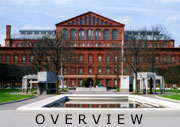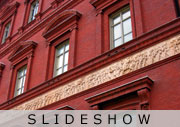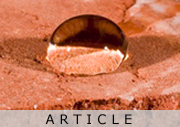Building Museum Building-Sized Paint Restoration
Washington DC: 2008

Originally envisioned as a masonry cleaning project, it quickly became clear most of the white blooms on the exterior of the National Building Museum were not from soiling or salts created using typical masonry restoration cleaners. As it turns out, the bricks were painted. Removing bricks from around the building, it also became clear that this was not a later treatment: the bricks had been dipped in paint before they were laid. Stripped of this paint, the bricks were coarse, looking more like sewer tiles, and would have undermined the homogeneous appearance intended by the building's designer, Army Quartermaster Montgomery Meigs, who wanted the terra cotta, bricks and mortar to match. Analysis indicated the paint was an oil-bound casein. After 120 years this paint remained mostly red, but in some areas had turned white where the paint had been broken down until the red pigments were no longer saturated with binder. Seeking to preserve the original finish while re-saturating the lost color, the Building Museum treatment used a non-ionic electronics industry cleaner and a cosmetics industry resin sometimes used in sunscreen to protect and knit the pigment particles back together.
 |
 |
 |
Building Museum: Overview |
Building Museum: Paintings Conservation in Disguise |
Chemist's Commentary on Treatment Approach |
